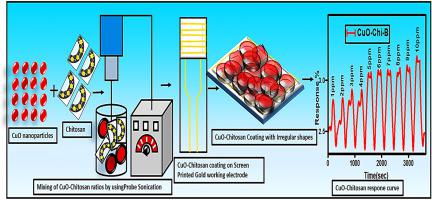Materials Today Chemistry ( IF 6.7 ) Pub Date : 2023-04-07 , DOI: 10.1016/j.mtchem.2023.101503 A.S. Neetha , K.V. Rao

|
This report describes a simple and inexpensive room-temperature chemo-resistive CuO-Chitosan-based hydrogen sensor for detecting gastrointestinal diseases (GIDs). A clinical analysis shows that GID patients exhale more than 10–20 ppm of hydrogen compared to healthy people, which is considered a biomarker for the non-invasive diagnosis of GIDs. This allows for a portable, non-intrusive, effective, and fast-detecting sensor in treating GIDs. To our knowledge, no GIDs study has used chitosan for H2 sensing. The current study prepares CuO-Chi nanocomposites and tests their hydrogen sensitivity for GIDs detection. Different ratios of CuO: chitosan [CuO: Chi (A(1:2), B(1:1), C(1:0.5), D(1:0.25), E(1:0.125), and F(1:0.0625)]were synthesized using novel co-precipitation cum probe sonication technique. Compared to other CuO composites in the literature, our synthesized CuO: Chi-B (1:1) can detect as low as 10 ppm of hydrogen gas at room temperature, with a lower limit of detection (0.07 ppm) and a regression coefficient (R2) of 0.9566. The Contact angle explains the anti-wettability property with the increase in the hydrophilicity due to the presence of electronegative atoms like N in NH2 and O in the OH group. Field emission scanning electron microscopy reveals several single broccoli nano florets. Most importantly, the sensor's calculated Brunauer–Emmett–Teller surface area is 5.1565 m2/g with a pore volume of 0.02173cm2/gm and pore size of 16.897 nm. It has excellent sensitivity, response, recovery, reproducibility, stability, and selectivity. The reaction mechanism for sensor performance is elaborately discussed by the Grotthuss mechanism. The above studies suggest and show that CuO: Chi-B (1:1) is a new material for hydrogen sensors that can be used for the breath analysis to detect GIDs at 10 ppm.
中文翻译:

基于氧化铜壳聚糖的西兰花形纳米小花胃肠道疾病检测
本报告描述了一种用于检测胃肠道疾病 (GID) 的简单且廉价的室温化学抗性基于 CuO-壳聚糖的氢传感器。一项临床分析表明,与健康人相比,GID 患者呼出的氢气多于 10-20 ppm,这被认为是 GID 无创诊断的生物标志物。这允许在治疗 GID 时使用便携式、非侵入性、有效且快速检测的传感器。据我们所知,没有 GIDs 研究使用壳聚糖来处理 H 2感应。目前的研究制备了 CuO-Chi 纳米复合材料并测试了它们对 GIDs 检测的氢敏感性。不同比例的CuO:壳聚糖[CuO:Chi (A(1:2), B(1:1), C(1:0.5), D(1:0.25), E(1:0.125), F(1 :0.0625)]是使用新型共沉淀暨探针超声处理技术合成的。与文献中的其他 CuO 复合材料相比,我们合成的 CuO: Chi-B (1:1) 可以在室温下检测低至 10 ppm 的氢气, 检测下限 (0.07 ppm) 和回归系数 (R 2 ) 为 0.9566。接触角解释了由于 NH 2 中 N 等负电原子的存在导致亲水性增加的抗润湿性和 OH 基团中的 O。场发射扫描电子显微镜揭示了几个单一的西兰花纳米小花。最重要的是,传感器的计算 Brunauer–Emmett–Teller 表面积为 5.1565 m 2 /g,孔体积为 0.02173cm 2 /gm,孔径为 16.897 nm。它具有出色的灵敏度、响应、回收率、重现性、稳定性和选择性。Grotthuss 机制详细讨论了传感器性能的反应机制。上述研究表明,CuO: Chi-B (1:1) 是一种用于氢传感器的新材料,可用于呼吸分析以检测 10 ppm 的 GID。







































 京公网安备 11010802027423号
京公网安备 11010802027423号